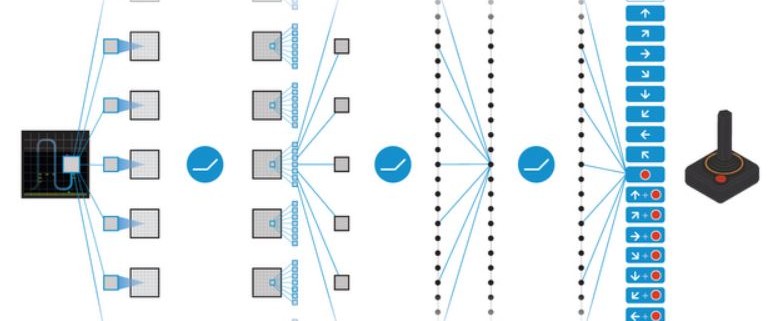Machine Learning in Nature
Apart from occassional news entries, comptuer science rarely makes it into Nature. A quick count in the Web of Science results in 33 articles, the last one – a year ago – by Ekert, A. & Renner, R. 2014. The ultimate physical limits of privacy. Nature, 507, (7493), 443-447, and the most prominent one surely the one with 3,200 citations by Strogatz, S. H. 2001. Exploring complex networks. Nature, 410, (6825), 268-276.
Now, machine learning has made it into Nature: The group of DeepMind Technologies founded by Demis Hassabis in 2011 as a start-up company, and purchased by Google for approx. 400 Million USD in 2014, has published a paper, which appeared today, 26.02.2015:
Mnih, V., Kavukcuoglu, K., Silver, D., Rusu, A. A., Veness, J., Bellemare, M. G., Graves, A., Riedmiller, M., Fidjeland, A. K., Ostrovski, G., Petersen, S., Beattie, C., Sadik, A., Antonoglou, I., King, H., Kumaran, D., Wierstra, D., Legg, S. & Hassabis, D. 2015. Human-level control through deep reinforcement learning. Nature, 518, (7540), 529-533.
Abstract: The theory of reinforcement learning provides a normative account, deeply rooted in psychological and neuroscientific perspectives on animal behaviour, of how agents may optimize their control of an environment. To use reinforcement learning successfully in situations approaching real-world complexity, however, agents are confronted with a difficult task: they must derive efficient representations of the environment from high-dimensional sensory inputs, and use these to generalize past experience to new situations. Remarkably, humans and other animals seem to solve this problem through a harmonious combination of reinforcement learning and hierarchical sensory processing systems, the former evidenced by a wealth of neural data revealing notable parallels between the phasic signals emitted by dopaminergic neurons and temporal difference reinforcement learning algorithms. While reinforcement learning agents have achieved some successes in a variety of domains, their applicability has previously been limited to domains in which useful features can be handcrafted, or to domains with fully observed, low-dimensional state spaces. Here we use recent advances in training deep neural networks to develop a novel artificial agent, termed a deep Q-network, that can learn successful policies directly from high-dimensional sensory inputs using end-to-end reinforcement learning. We tested this agent on the challenging domain of classic Atari 2600 games. We demonstrate that the deep Q-network agent, receiving only the pixels and the game score as inputs, was able to surpass the performance of all previous algorithms and achieve a level comparable to that of a professional human games tester across a set of 49 games, using the same algorithm, network architecture and hyperparameters. This work bridges the divide between high-dimensional sensory inputs and actions, resulting in the first artificial agent that is capable of learning to excel at a diverse array of challenging tasks.
Subject terms: Computer Science
The editors summary: For an artificial agent to be considered truly intelligent it needs to excel at a variety of tasks considered challenging for humans. To date, it has only been possible to create individual algorithms able to master a single discipline — for example, IBM’s Deep Blue beat the human world champion at chess but was not able to do anything else. Now a team working at Google’s DeepMind subsidiary has developed an artificial agent — dubbed a deep Q-network — that learns to play 49 classic Atari 2600 ‘arcade’ games directly from sensory experience, achieving performance on a par with that of an expert human player. By combining reinforcement learning (selecting actions that maximize reward — in this case the game score) with deep learning (multilayered feature extraction from high-dimensional data — in this case the pixels), the game-playing agent takes artificial intelligence a step nearer the goal of systems capable of learning a diversity of challenging tasks from scratch.
More information: https://www.nature.com/nature/journal/v518/n7540/full/nature14236.html#tables




